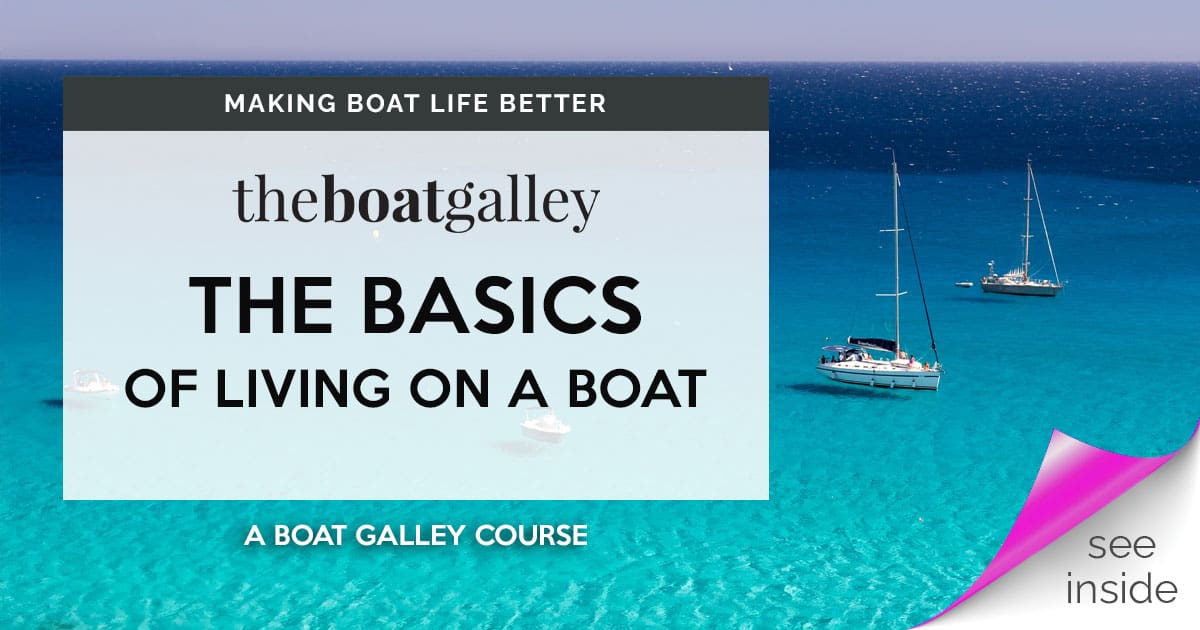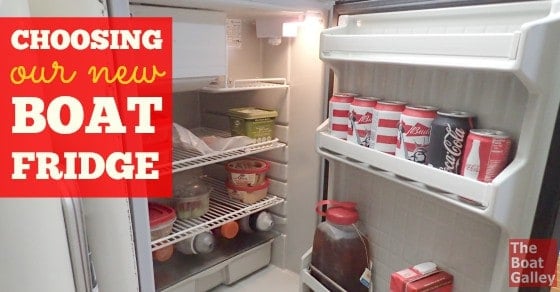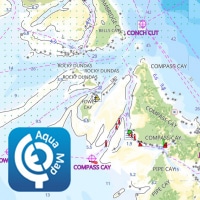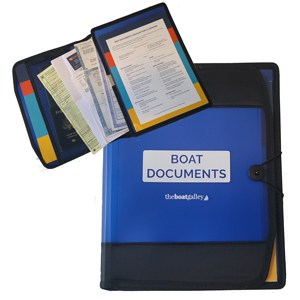One of our projects this summer was to replace the refrigerator on our boat, and I’ve gotten a whole bunch of questions in response to my Facebook and Instagram pictures about why we chose what we did and why we didn’t go with some other options.
Barefoot Gal was originally built with a Dometic propane/AC front-opening refrigerator, and she still had the original one when we bought her 16 years later.
Whenever we had AC power (shore power), we could run it off that. Otherwise, it ran on propane. These units were originally built primarily for RVs and were considered state of the art in the late 1990’s, before solar power became so abundant and cheap.
Our unit was badly rusted out and would barely keep food cool — not cold. The freezer did still freeze, however. But as it got warmer this past spring, it was obvious that we needed to replace the refrigerator — while we could, conceivably, replace parts, it was so rusted out that any repair would be temporary.
One option was to replace it with the current Dometic model of propane/AC (2-way) or propane/AC/DC (3-way). On the surface, this seemed like the easiest solution, but we’d have to run a DC wire for either one, as even the 2-way units now used DC power for an electronic controller. Additonally:
- Propane units are pretty inefficient and since they work off heat, they (1) add a lot of heat to the boat — in ours, right at the helm where the vent is, and (2) are even more inefficient when running on AC or DC power since the electricity is used to power a heater, not a compressor.
- A 15-pound propane tank only lasts 12 to 13 days in the tropics between the refrigerator and cooking. We felt like we were getting refills all the time. This would be a real pain in the Bahamas and other places where it’s not easy to find refill stations. We’re trying to make our boat less dependant on shore services.
- And the cost of the propane! Over $1.50 a day in the Keys; it’d be more in the Bahamas.
- The propane burner assembly takes up a lot of room in the refrigerator compartment — space that could be used (in a DC refrigerator) for more interior volume.
- When the unit is running on propane, there is always a pilot light burning and propane is always flowing. While propane disasters are rare, they are catastrophic. Having propane always burning just ups the chance of a problem.
- Related to the above is the fact that the pilot light is adjacent to the cockpit and the unit draws its fresh air from the cockpit. Transferring fuel in the cockpit, particularly gasoline for the dinghy or a generator, could cause gas fumes to be drawn into the pilot light and explode. We’re very careful not to fuel up in the cockpit, but are well aware that it only takes an instant of carelessness.
- And finally, with our solar panel upgrade last spring, we have plenty of power to run an efficient 12-volt refrigerator under most conditions, plus we have a Honda generator and our engine alternator as backups in case of prolonged cloudy weather.
To be honest, we’d pretty well decided that we wanted a unit that would run on DC even before I began my research, but we’d tended to think that we’d go with a 3-way unit so that we could run it off propane or AC if the need ever arose. It was only when I learned that the electrical source was simply powering a heater and I saw the power consumption numbers (15 amps DC around the clock, not cycling = 360 amp-hours a day) that I realized this was not for us.
So now we were looking at DC units. Several people have asked why we went with straight DC and not AC/DC, the idea being that we could run the refrigerator off AC when at the dock or in a boat yard. But the reality is that if we have access to shore power, it will be connected to our battery charger (we have a 75-amp shore charger) and we’ll have no problems powering the refrigerator off the batteries. Further, DC-only costs about $130 less — why pay for a feature we didn’t need?
We were hoping to find a refrigerator that would be efficient and fit into the spot already designed for the fridge. This meant another front-opening unit (Barefoot Gal is a catamaran; top-loading refrigerators are more common in monohulls). Neither Dave nor I are finish carpenters and having to do any substantial remodeling to the refrigerator area would add considerably to the cost of the project as we’d have to hire it done.
When we had cruised aboard Que Tal, almost all refrigerators were custom built and required either professional installtion or substantial DIY skills to build the box, insulate it and install the mechanicals. Now, drop-in units are the norm, whether they are top- or front-loading, and DIY installation is much simpler. While we never would have dreamed of building a refrigerator from scratch, we felt confident that we could install a drop-in unit that only requires you to run wires and secure the refrigerator to the boat.
When I first began looking at 12-volt refrigerators, I got a really nice surprise: I could get about 50% more interior volume than with a propane fridge with the same exterior dimensions. Going from 3 cubic feet to 4.5 would be a huge improvement! Admittedly, it’s still a small refrigerator, but not nearly as small!
After looking at unit sizes, amp draw and how generally satisfied other cruisers were with various brands and models, we ended up with with an Isotherm Cruise 130 Classic. General comments about it:
- Isotherm also makes an “ASU” unit which has a more sophisticated holding plate that’s chilled when battery voltage is high. After talking to company reps, it appeared that this feature was more useful on boats that ran a generator a few hours a day rather than one operating off solar power. If you are contemplating getting an Isotherm, talk with a rep yourself to decide what’s best for you (and, of course, they may have changed their recommendation . . .).
- Our unit draws a maximum of 5 amps with a stated average of 1.4 amps in 72° F. weather. We seem to be averaging about two amps over the course of a day here in the very hot and humid southern Florida summer — and we’re on the hard which is decidedly hotter than being in the water.
- Installation was relatively easy (as boat projects go). I spent 3 hours one day running the wire (how long this takes depends totally on your boat configuration) and Dave and I spent about 8 hours the next on getting it in place, of which 3 hours were removing the old propane lines that had been held in place with 5200, 1 hour was cleaning mud dauber nests out of the refrigerator compartment, 1 hour enlarging the cut-out in the compartment . . . twice, and another half hour finding the screw that dropped out of the electrical bus bar when we connected the wiring. Yes, it could be done faster if you didn’t encounter your own set of challenges.
- The Isotherm installation instructions are virtually non-existent, basically telling you what size wire you need and what size fuse. We had to contact the company we’d bought it from to find out how to attach the mounting flange as there were no screws, no screw holes and no instructions (it was a brand-new model change).
- The freezer on the Cruise 130 is tiny. Really tiny. That’s my only complaint with the unit. I love the produce drawer at the bottom of the refrigerator, and the extra space compared to the old fridge is fantastic. Our plan is to use the new refrigerator for a while and see if the small freezer is that big of a problem. If it is, we’ll probably get a small Engel unit to use as an auxiliary freezer.
- It has a light inside, a little feature that I’ve grown to love.
- It’s keeping food and drinks cold, which was the whole objective!
UPDATE SEPTEMBER 2016: After a year of using the refrigerator, I’d give it a B grade. It is energy efficient and offers a lot of usable space. Installation was easy. It just works without a hiccup. Food and drinks are cold. That’s all the good stuff — it is way, way better than our previous propane refrigerator.
The bad is that the door latch is on the flimsy side and we’ve had to bend it slightly a couple of times so that the door actually latched shut. The seal isn’t very tight and frost builds up quickly (I defrost about every 10 days in the heat and humidity of summer). And the biggest problem has been that the freezer door hinges have broken twice . . . I got a warranty replacement the first time; the second time I realized that it is simply a poor design that is going to break with even the tiniest bit of ice buildup (it broke two days after I had defrosted!) and so I’m working on my own re-engineered version that hopefully won’t break.
Bottom line: It’s been a huge improvement and was the best choice available, but no, like most things, it’s not perfect. Read an update on this post.

Carolyn Shearlock has lived aboard full-time for 17 years, splitting her time between a Tayana 37 monohull and a Gemini 105 catamaran. She’s cruised over 14,000 miles, from Pacific Mexico and Central America to Florida and the Bahamas, gaining firsthand experience with the joys and challenges of life on the water.
Through The Boat Galley, Carolyn has helped thousands of people explore, prepare for, and enjoy life afloat. She shares her expertise as an instructor at Cruisers University, in leading boating publications, and through her bestselling book, The Boat Galley Cookbook. She is passionate about helping others embark on their liveaboard journey—making life on the water simpler, safer, and more enjoyable.
Here’s your “Quick Start” to everything you need to know when living on a boat:











Mimi Schwartz Laser says
I have isotherm refrigerator drawers and love them! Everyone says parts for boats cost more, these were less than sub zero drawers!
The Boat Galley says
I would have loved to get the drawers but just not in the budget — the size would have necessitated some re-working of the space, too.
Mimi Schwartz Laser says
Luckily the drawers were the only thing that fit in the space without reworking. Most importantly they were the only thing that fit through the door opening. Freezer chest in cockpit. We have 65 foot motor yacht, much different than your situation with your yacht
The Boat Galley says
I know all about the door problem! Out old refrig had to be dismantled to get it out, and the new one came in with about 1/8″ to spare . . . something I’d learned from the Gemini owner’s group!
Gaye Richardson says
hubby bought a commercial ss bar size fridge freezer at about half the price with more freezer space and we are running it on 115 off our solar panels
The Boat Galley says
WOW! I’ve never heard of someone having enough solar to do that. Sounds like a great idea. How much does it draw and how much solar do you have?
Gaye Richardson says
six 200 watt solar panels – draws 66 amps – hubby is an expert on power and electrical systems – should see the designs hes done for our boat – we have two zanetrex 3000 wattt inverters wired to provide 115 and 230 allowing use of commercial equipment
Gaye Richardson says
gerry douglas from catalina yachts used some of his ideas in their upgraded 36 (true story guys – TRUE story)
The Boat Galley says
Lucky you!
Gaye Richardson says
well we cant sail right now – not in the usa
Patti Holma says
If you do get an Engle you’ll love it! I’ve used ours in different ways to figure out what’s best for us. Freezer was excellent but after all variations I tried, now use it for fruits and veggies. Don’t need it to run it as often which is nice and I now don’t have to rearrange everything in the fridge to accommodate the odd shapes. We have a top loading freezer with ample space
Dave Lerbs says
Thanks for your wonderful report. As the Isotherm distributor, we are happy to see your review as we don’t do much in the way of advertising. We rely on consumers to tell their friends and fellow boaters!
Isotherm offers the fullest range of refrigeration products in the marine industry.
Beyond the regular Classic and Stainless Steel models which are naturally energy-efficient due to design, additional battery savings can be achieved with Isotherm ASU models that have a built-in holding plate,
Isotherm also offers the new Isotherm Smart Energy Control which senses surplus power (like from a solar panel or engine alternator) and runs the compressor at high speed to drop temperatures in the fridge to lower levels which is absorbed in food and beverages (like the ASU does with the holding plate). Then, on battery power alone, the fridge is allowed to return to normal operating temperatures around 40 degrees F then runs the compressor at slower speeds to conserve battery power. The result is 30 to 50 percent less battery consumption.
For cruisers seeking additional freezer capacity, Isotherm has top-loading boxes with remote-mount compressors which can fit under bunks, settees, or in a lazarette. Additionally (as you noted), the portable freezer is a great alternative to building in more capacity. Isotherm has unique 2-speed portable refrigerator or freezer models that can be turned up to fridge temps or down to freezer temps. With digital display and the MAX mode (high speed for fast cooling with surplus power) or ECO mode (slow speed for economical battery consumption), the Isotherm Travel Boxes are a reliable way to add more capacity and versatility, running on DC power (with a cigarette connector for car or boat) and AC power with a plug as well.
Dependability and performance are Isotherm hallmarks. All Isotherm compressors are backed with a 5-year limited warranty (3 years on portable units) and two years on all other parts so you’ll have the confidence of knowing you’re purchasing a quality product. We are also available by email or phone to answer your questions with contact information on our website.
Thanks again for your wonderful review. Happy cruising!
Ellen says
Carolyn, does the ASU holding plate keep the food colder longer? Does it work on the same principle as the pizza stone in the oven to evenly distribute the heat? Just trying to think up alternatives to buying a new fridge.
Carolyn Shearlock says
It’s something that’s built into some of the Isotherm refrigerators, not a standalone item that can be retrofitted into an existing refrigerator as far as I know.
Windsong II says
Ellen, I don’t know how your fridge/freezer is configured now so this might not work for you.
We have a large top loading freezer and top loading fridge. I used the remote readout thermometers to determine both had big fluctuations in temperature. I am able to keep 20 lbs of ice in the freezer all the time. I found this helped a lot to keep the temp more even especially when adding some unfrozen meat ect. It provides a large thermal mass. The second thing was to replace the mechanical thermostats with electronic ones from Amazon, about $20 each. They can be adjusted to turn on with only a 4* temp. difference, the mechanical ones were almost 10*.
https://amzn.to/2y2yfBa
Bob
Ellen says
That’s why I LOVE this website–such a wealth of information! Thank you Bob and Carolyn!
thomas o'shea says
I purchased the same frig have same boat. How much did you enlarge the openning?And did you close off the old vents for the Dometic?
Carolyn Shearlock says
We had to make the opening approximately 1/2″ wider — measure yours as not all Geminis have exactly the same cut out. We did NOT close off the Dometic vents — our Isotherm dealer is emphatic that the more air flow, the better!
Hugh Burton says
We went with an ARB 50 AC/DC fridge freezer for our Mac 26M
It runs easily with a 100W panel as the Macgregor does not have a lot of electrical demand.
When in the slip we run AC.
David Lake says
get the biggest dang one that fits,….if it don’t fit,.get a saw
Justin Grunwald says
Emma Barr this is a good read
Emma Barr says
Thanks will have a look! 🙂
Mark Sidmore says
first rule: Be sure it will fit through the hatch. after that, its all easy
The Boat Galley says
Always a consideration!
Jim @ Homeontheloose.com says
Great review, thank you! We also got a Cruise 130 but for our campervan build. Our solution to the latch issue was to put a bungee across the fridge door while we are driving about. It keeps the door shut during transit and then we can unhook the bungee when we make camp. It’s been a great unit for us and it’s good to hear about how it performs on water.
Ray says
Vitrifrigo has been recommended to us. We need to replace a 12 year old Jenn-Air UnderCounter AC refrig. It draws alot of amps when it’s running good, and alot more when it’s on the fritz now. Ordering our Vitrifrigo soon, so if anybody has any complaints…..
Sean M Dickens says
I just bought a CR130 to add an extra refer. I am now considering getting another to replace my original built in unit. It is a air/keel cooled frigoboat, 17yo, and the refer is not cooling very well. It won’t fall below 48. My concern is the Isotherm is air cooled, and we will be in the tropics 100% of the time. I think I have the room to add some more insulation, if I install the CR130, but how efficient is it, really?? Are you still happy with yours 3 years later? Do you still have door seal issues? I am not worried about the little freezer, I would get the drink model. It would cost me about double to put in new compressor, cooler, etc, but possibly more efficient. Before I tear out my built in, I am trying to make sure I am going to have a good unit. Thank you for your help.
Carolyn Shearlock says
Due to the problems we were having, they exchanged our refrigerator for their Elegance model. It is much, much better — the door seals are greatly improved as is the latch.